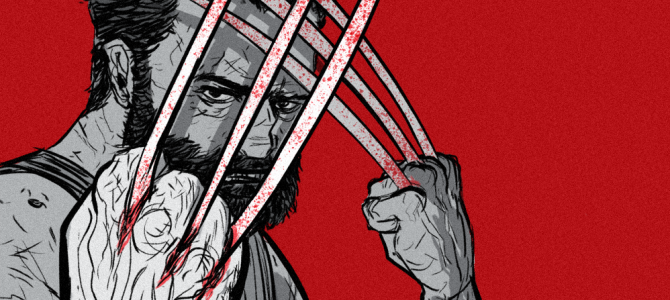
The Marvel movies have a common problem: they lack conflict, both externally from villains and internally from lead characters’ emotional conflicts. “Logan” provides an example for the Marvel movies to follow. It builds conflict in an emotionally gratifying way, unlike the largely forgettable conflicts within existing Marvel movies.
The Marvel Avengers Have Weak Conflicts
The foes the various members of the Avengers square off against are never threatening enough that viewers fear for the heroes’ lives. Loki is “fun” to watch, but his performance is more akin to Jack Nicholson’s Joker, a fun character that lacks a threatening feel. In contrast, Heath Ledger’s Joker is a force of chaos. Recall the scene where he holds the fake Batman hostage. That is a frightening moment, and none of the Marvel villains ever manage to pull off something similar. “Guardians of the Galaxy” is widely considered one of the best Marvel movies, but the lead villain’s motivations are “get the macguffin,” and without consulting Wikipedia most people couldn’t name him.
With the third Avengers movie coming soon and a “Guardians of the Galaxy” sequel coming even sooner, Marvel will likely continue its theme of having an entertaining main cast, fun yet forgettable set pieces, a general lack of stakes, feel-good outcomes, and in the case of “Guardians of the Galaxy Vol. 2,” a nostalgia-laden soundtrack.
The next Avengers movie’s villain is Thanos. We’re getting into some nerd territory here. He’s the purple guy who’s super into gems. His motivations are: collect gems, rule universe. In the comics he’s in love with Mistress Death, a skeleton lady. He has to kill stuff to keep her happy. It’s weird. Thanos represents just another in a long line of forgettable modern action villains whose motivations are so big they take the stakes of the action from “this city will be destroyed” to “this country” to “the earth” to “galaxy.”
The problem of weak villains can be resolved with good character-driven conflict, emotional arcs that have weight. However, the characters within the Marvel movies have all become varying levels of Robert Downey Jr’s Iron Man, with varying levels of rude behavior. Each character speaks with the patented Whedon trifecta of snark, hippness, and in-jokes. They’re punchline delivery systems rather than fully formed characters. Captain America’s entire “man out of time” dilemma is cut down to a joke about him adding movies and albums to a list.
What ‘Logan’ Can Teach the Marvel Universe
Future Marvel movies ought to look to Logan for inspiration (some spoilers to follow). The movie’s on-paper villains aren’t particularly compelling. A scientist who was able to stop the mutant gene from appearing has been making his own weaponized mutants, and is aided by a mercenary force with robotic limbs. This provides lots of disposable things for Logan and Laura to slash their way through. However, the villains don’t have to do the work of building conflict in this movie. They only fulfill the action quota.
Instead, the entire movie is built on a ticking clock, each character is driven by a fear of time. Professor X is basically living with Alzheimer’s, needing regular medicine doses or he loses control of his powers and shuts down the brains and motor functions of everyone around him. Logan’s healing powers are failing, and he’s been poisoned by the metal that made him invulnerable. He’s trying to save up to put himself and Xavier on a boat and drive out into the middle of the ocean where they can die in something akin to peace. Laura escaped her captivity in the lab she was grown in (sound familiar?) and must arrive to a safe haven within a specified window of time to escape the aforementioned evil scientist.
The action stakes in Logan are small. There is no ancient Egyptian mutant god trying to bring about the end times, timelines aren’t being altered to deter the advance of Sentinels and post-apocalyptic mutant death camps, there is no climactic fight atop the Statue of Liberty where a costumed villain attempts to kill everyone in New York City.
No, the action scenes in Logan are small and brutal. They take a toll on the characters. Throughout the movie, Logan’s scars are visible. As much as people anticipated seeing Logan really bare his claws and shred bad guys, he does so at his own peril, with the camera lingering on the sucking wounds that he incurs throughout, reminding the viewer of the toll violence takes. Keeping the focus on the effects action has on the characters keeps the character front and center, giving us the most human superhero story that we’ve seen on screen. This is something other Marvel movies lack.
A Human Narrative We Can All Relate To
Combining the various narrative ticking clocks and visual reminders that no one is impervious to violence keeps the tension high and allows the viewer to really focus on the small cast on display and their interaction with the real foe of the movie: time.
Consider that Logan could be summarized thusly: a man dying from cancer takes his estranged, traumatized daughter and 90-year-old father with Alzheimer’s on a road trip to drop her off with a new family before they both die from their illnesses. Then consider the summary of the plot of “Captain America: Civil War”: super-powered people get into big fights about whether the government should make them join a registry.
One is easily relatable, the other is not. The fear of the inevitable in “Logan” makes it a more effective movie than prior X-Men and Marvel movies, by forcing the characters to reconcile with a foe and situations which every member of the audience can relate to. Marvel would be wise to give their movie characters something real to struggle with rather than simply throwing pixels at the screen and promising ever-increasing scales of destruction.









